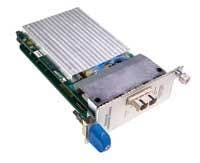by Meghan Fuller
Today’s carriers are increasingly concerned with collapsing or converging their disparate networks into a single, Internet Protocol (IP)-based network. And this convergence often extends to individual network elements themselves, where the functionality of two or more platforms can be collapsed into a single box that retains the benefits of each. Several router vendors, including the big three of Cisco, Alcatel-Lucent, and Juniper, are integrating WDM optical transport-a Layer 1 function-into Layer 3-based service routers in an effort to streamline costs and complexity. While the router vendors are bullish on the economics and efficiency resulting from this integration, the WDM folks say they will stick to transport, thanks.
Sources at Cisco Systems (www.cisco.com) say the trend of integrating WDM capabilities into switch routers is global, and they note that many customers have already deployed Cisco’s architecture or are in lab or field trials. Cisco recently announced the integration of a WDM transponder directly inside the router-in this case, the CRS-1 Carrier Routing System-to enable that router to transmit ITU-compatible colored wavelengths.
To explain why such integration results in a more efficient network, Mike Capuano, senior product marketing manager at Cisco, provides a little history lesson. When fiber networks first were constructed, they were overlaid with a SONET/SDH layer to transport circuit-based TDM services. That SONET/SDH or electrical grooming layer provided three basic value propositions, he says. First, it aggregated all the TDM traffic-T1/E1s and T3/E3s-into bigger pipes of 2.5 Gbits/sec, 10 Gbits/sec, etc. Second, the electronic grooming layer provided operations, administration, and maintenance (OAM) or health statistics for those TDM connections, and this data was sent directly to the operations support system (OSS). Finally, the SONET/SDH layer provided protection and 50-msec restoration.As IP became more popular as a mechanism for packet-based service delivery, many carriers built IP networks on top of the SONET/SDH layer. Now, the interesting thing about IP routers is that they can provide the same functionality as the electrical crossconnect system at 10 Gbits/sec and beyond, maintains Capuano. First, the router performs the aggregation function, “so you don’t need [electrical grooming for] that anymore,” he says. “And if you have the router spit out a colored lambda and wrap it with a G.709 digital wrapper, that gives you SONET/SDH-like OAM information. The third function is fast restoration. Most providers have deployed MPLS [multiprotocol label switching] in their backbone, which enables MPLS fast re-route, which gives you 50-msec failover, again at the IP layer,” Capuano concludes.
Because critical functionality is now provided by the router, carriers can effectively eliminate the entire middle layer of optical crossconnects, he contends.
Previously, the router would transmit a standard short-reach “gray” or alien wavelength that is either 1,310 or 1,550 nm. (Because the router is only transmitting one wavelength on the fiber, there is no reason to use an expensive ITU-quality laser.) Say you wanted to transmit the router traffic directly into a DWDM system. The router would transmit the gray wavelength into a transponder, and the transponder would then perform an OEO conversion on the wavelength to convert it into a colored or ITU-compatible wavelength for transport to another optical element, such as a reconfigurable optical add/drop multiplexer (ROADM).
But, as Capuano is quick to point out, each one of these transponders requires significant rack space. A fully loaded CRS-1, for example, supports 64 10-Gbit Ethernet (10GbE) wavelengths, which would require four shelves of transponders via the gray wavelength application. Instead, Cisco integrates the transponder technology directly into the CRS-1. “And basically, those four transponder shelves go away,” says Capuano. “You don’t have to buy them anymore, you don’t have to maintain them anymore, and you don’t have to use rack space, power, or cooling. The colored wavelengths go right from the CRS-1 into a ROADM, typically.”
While he admits that customers will pay more for this interface-“We had to pay to add the transponder functionality”-overall, it is much less expensive than multiple shelves of transponders, says Capuano.
Cisco achieves this functionality via a physical line interface module (PLIM) with integrated transponder functionality at both 10- and 40-Gbit/sec speeds. Both the CRS-1 one-port OC-768c/STM-256c WDM POS Interface Module and the CRS-1 four-port 10GE WDM PHY Interface Module feature full C-band tunability.
Cisco admits that it has a competitor whose router also has the ability to output a colored wavelength, but this competitor does not provide G.709 Digital Wrapper technology, says Capuano. “They can’t provide the statistics that are needed by operational support systems.” Moreover, he says, they have not incorporated forward error correction (FEC), which enables Cisco’s CRS-1 to transmit up to 1,000 km without regeneration.
The competitor to which Cisco refers is presumably Alcatel-Lucent (www.alcatel-lucent.com), which also uses colored optics to enable its routers, including the 7750 Service Router and the 7450 Ethernet Service Switch, to transmit ITU-compatible wavelengths. Alcatel-Lucent says it now can populate existing universal gigabit or GbE ports on the 7750 or 7450 with SFPs or XFPs that support eight colors for a CWDM implementation. “You take the eight gigabit ports, you put in the colored optics, and that connects into a mux-type unit like Alcatel-Lucent’s MetroSpan,” explains Steve Shalita, senior director of product marketing in Alcatel-Lucent’s IP Division.
“When we talk about why we do it within the routing platform, it’s really just to improve efficiency,” he says, “to drive the effective use of bandwidth both within the switch router as well as in the fiber infrastructure.” Integrating colored optics not only simplifies the network but also results in fewer points of potential failure, says Shalita.
“If I’m making a traditional connection from the switch router into an optical device, then the optical device [must] colorize it [i.e., perform the OEO conversion] and split it and put it over the fiber. That’s just a point of failure I can simplify by putting [colored optics] into the platform and making it much more efficient,” he explains.
Alcatel-Lucent says it has had integrated CWDM capability for the last three years. Shalita confirms that the vendor is “looking at and working on the ability to support 32 colors or wavelengths on DWDM also within the 10-Gbit/channel range. It’s just a matter of qualifying and adding the optics to the platform.”
Shalita says he has not seen much demand from customers for tunable interfaces, noting that Alcatel-Lucent has “pretty much stayed with the fixed-wavelength optics.”
Juniper Networks (www.juniper.net), meanwhile, has its own optical transport integration strategy in the form of tunable DWDM interfaces, such as the 10GbE tunable physical interface card (PIC) designed for its M- and T-series routers. According to Alan Sardella, product marketing manager for Juniper’s core routing products, the integration of tunable DWDM interfaces provides advantages in terms of cost and control. “The main point is to be able to define something that is going to run over the transport network that you are going to control from the routing network,” he explains.Like Cisco and Alcatel-Lucent, Juniper touts the benefits of integration to eliminate an unnecessary OEO conversion. “The only way to get the kind of control that you need over the transport network would be with much more expensive transport gear, such as optical mux equipment,” says Sardella. “And that mux would actually have to take the signals into the electrical domain and then back into the optical domain as part of the regeneration process to get the signals across a long distance. Having the DWDM gear within the router, you can use much less expensive transport gear, such as passive optical muxes. And the wavelength management can largely be handled by the router.”
Because additional wavelengths can be added to the system via a simple software adjustment, the tunable DWDM PIC eliminates the need for external transponders in the network, thereby reducing both capital and operational expenditures, says Sardella.
Last December, Juniper unveiled a 4xOC-192 PIC, which features a 10-Gbit/sec XFP optical transponder. The 4xOC-192 PIC supports a 1×40-Gbit/sec implementation using an alien wavelength that connects the router and passive multiplexer. The new PIC also allows customers to “route at 40 Gbits/sec but put the wavelength through the network at 10 Gbits/sec through a process called inverse multiplexing,” Sardella explains. The 4xOC-192 PIC allows the router to transmit four 10-Gbit/sec wavelengths either on four separate fibers or on a single fiber, which Sardella says is “the most interesting application.”
“In this way, the transport people get to do business exactly as they want to,” he notes. “They get to just watch the wavelengths to see if they are drifting or if the current is changing or if they aren’t getting enough power, etc. And the routing people get to route at 40 Gbits/sec.”
All three vendors admit that some management or control plane issues arise from the integration of the WDM and routing. There is sometimes “tension,” to borrow Sardella’s word, between the transport (i.e., SONET and DWDM) side of the house and the services (i.e., IP) side of the house. But all three vendors say they have mechanisms in place for either maintaining this separation or unifying control of the system, depending on the carrier’s preference.
Sardella says he’s heard folks talking about taking this integration a step further, combining optical gear like OADMs with routing gear. So far, however, this appears to be just talk, in part because the resulting network element would be too complex. “There would be difficulties marketing that, and where would it really fit?” he muses. He believes customers are more interested in managing “the continuing torrent of traffic growth. It’s a tidal wave, really, to the tune of 80% [growth] per year. They need the transport equipment to be aware of what the IP equipment, which tends to be more geared toward the services, is going to be sending it. And the optical interfaces on the routers tend to provide that.”
For their part, the traditional transport vendors seem to have little interest in integrating router technology into their WDM equipment. “We are not claiming to be a router,” says Sam Lisle, director of market development for Fujitsu Network Communications (www.us.fujitsu.com), of the company’s new Optical Packet Networking Platform. He notes that service platform vendors tend to operate under the assumption that optical networking functionality is a commodity, but Fujitsu disagrees. Moreover, he says, most vendors are not investing strongly in both WDM and routing; it’s usually either/or. And most customers buy their WDM equipment and their routing equipment from different vendors.
Integrating an aggregation function into the router to solve a transport problem doesn’t seem very likely in the telco environment, admits Lisle, who suggests that such an implementation might be more easily sold to a Time Warner than an AT&T. (Interestingly, one of the big customers Cisco touts for its PLIM-enhanced CRS-1 is Comcast Corp.)
ADVA Optical Networking’s (www.advaoptical.com) Brian McCann, chief marketing and strategy officer, echoes Lisle’s sentiments, saying that ADVA is “absolutely not” contemplating an entrance into the router market. ADVA is only interested in Layer 1 and Layer 2, he says. Nor is he particularly concerned that optically integrated routers from the likes of Juniper and Cisco will result in increased competition from a WDM perspective. On the contrary, he maintains that these offerings will only serve to proliferate WDM technology throughout the network.Meghan Fuller is senior editor at Lightwave

